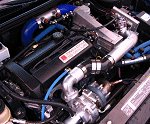

|
Street Class Unlimited Class
DOHC SOHC Ion Updated 1/05 For the most recent list of the fastest five cars click here. |
Deciphering Compressor MapsPart 2by: TitanAfter reviewing the article Deciphering turbo compressor maps I noticed that I had left out a few things. That's not to say there is anything wrong with the article but, by taking into account a few extra variables an even better turbo match can be made. This will require a bit more math but I think that in the end you will agree that it's worth it. Air Temperature Air temperature is an important variable because as the temperature increases the volume of air also increases. The following equation solves for ideal temperature rise, which is the temperature rise equivalent to the amount of work it takes to compress the air. Simply stated, the more you compress air (raise boost) the more the air becomes heated. Equation Variables First, we need to solve for T1 In this example we will assume that the inlet temperature, which
can also be interpreted as ambient temperature, is 80° F. Solving
for T1 we get the following equation: Next, we need to solve for P2 P2 = P1 + desired boost In this example we will assume a desired boost of 10psi. 24.7 = 14.7 + 10 T2 = T1 (P2 / P1 )^0.283 Variables Solving for T2 T2 = 540 (24.7 / 14.7 )^0.283 = 625.43 Then take the answer for T2 and subtract 460 from it 625.43 – 460 = 165.43° F The ideal turbo outlet temperature equals 165.43° F, which is a raise in temperature of 85.43° F over the assumed starting inlet temperature of 80° F. Giving us a ideal outlet temperature rise of 85.43° F. (165.43 – 80 = 85.43)
We have solved for the ideal outlet temperature of the turbo, which assumes 100% adiabatic efficiency (AE). At 100% AE there is no loss or gain of heat from the turbine but in the real world AE's normally run between 60-75% and we need to compensate for this. The following equation allows us to compensate for a less than perfect AE. Ideal Outlet Temperature Rise / AE = Actual Outlet Temperature Rise The basic plots diagramed in the previous article Deciphering turbo compressor maps gives us a good idea of which efficiencies the turbo will spend most of it’s time. In the image below we see two points located within the 74% range and one point in the 70% range. I decided to take the average of the three points (74 + 74 + 70 / 3 = 73) and use that as my compensated AE value. If we assume that the compressor has an AE of 73% then the outlet temperature will be 27% higher than the ideal outlet temperature (100 – 73 = 27). Again the equation is: Ideal Outlet Temperature Rise / AE = Actual Outlet Temperature Rise Substituting our numbers in we get: 117.02° F is the Actual Outlet Temperature Rise, which once added to the inlet temperature (80° F) gives us the actual outlet temperature. 80 + 117.02 = 197.02° F 197.02° F is the actual outlet temperature of the turbo without using an intercooler.
Air temperature and adiabatic efficiency have a profound effect
on the air density ratio. (T1 / [T1 + Actual Outlet Temperature Rise]) x (P2 / P1) = Air Density Ratio Plugging our numbers into the formula we get: (540 / [540 + 197.02]) x (24.7 / 14.7) = Air Density Ratio Stepping through the math: (540 / 737.02) x (24.7 / 14.7) = 1.23 1.23 is the Air Density Ratio To find out the difference in volume the heated air makes we need to compare the turbo's inlet airflow with the outlet airflow. Taking all of the variables into account we will now be able to find the turbo's actual outlet airflow in CFM by using the following equation. Turbo Outlet CFM* x Density Ratio = Actual Outlet CFM 171.16 x 1.23 = 210.53 CFM Reviewing the first article Deciphering turbo compressor maps we see that the value of 19.84 lbs/min was given for an engine running 10psi of boost without correcting for any variables. Using the corrected formula above we find that the same 10psi yields 14.53 lbs/min, which represents a difference of 27%. This is a sizable drop in airflow from theoretical (the first article) to the more accurate (this article). Nevertheless, the key to finding the turbo best suited for your application is to make sure that the airflow and pressure ratios intersect at a flow value no less than 60%. Also, there will most likely be several compressor maps that fit your application if this is the case it is advisable that you pick the compressor that has the lowest surge air flow limit. This will insure that you have the widest range of performance at that boost. Armed with this additional information you should be able to better calculate your turbo’s actual airflow numbers. *Boost pressure will be the absolute value, which is 1+ what you are boosting. For example if your are boosting .7 bar add a 1 before you insert the value into the equation. By adding 1 you are compensating for the 1 bar of standard atmosphere pre-boost. Converting CFM to lbs/min Pressure Conversions: |
|



